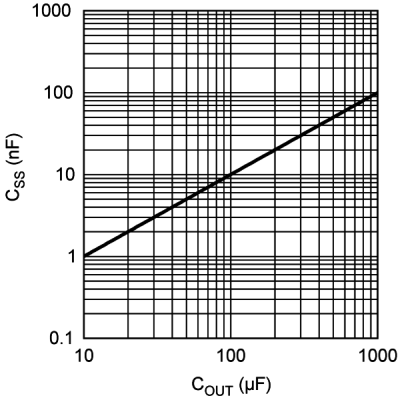JAJSAB5F December 2006 – November 2016 LP38853
PRODUCTION DATA.
- 1 特長
- 2 アプリケーション
- 3 概要
- 4 改訂履歴
- 5 Pin Configuration and Functions
- 6 Specifications
- 7 Detailed Description
- 8 Application and Implementation
- 9 Power Supply Recommendations
- 10Layout
- 11デバイスおよびドキュメントのサポート
- 12メカニカル、パッケージ、および注文情報
- 12メカニカル、パッケージ、および注文情報
パッケージ・オプション
メカニカル・データ(パッケージ|ピン)
サーマルパッド・メカニカル・データ
発注情報
7.3.4 Soft-Start
The LP38853 incorporates a soft-start function that reduces the start-up current surge into the output capacitor (COUT) by allowing VOUT to rise slowly to the final value. This is accomplished by controlling VREF at the SS pin. The soft-start timing capacitor (CSS) is internally held to ground until both VBIAS rises above the UVLO threshold and the EN pin is higher than the VEN(ON) threshold.
VREF rises at an RC rate defined by the internal resistance of the SS pin (rSS) and the external capacitor connected to the SS pin. This allows the output voltage to rise in a controlled manner until steady-state regulation is achieved. Typically, five time constants are recommended to assure that the output voltage is sufficiently close to the final steady-state value. During the soft-start time the output current can rise to the built-in current limit.
Because the VOUT rise is exponential, not linear, the in-rush current peaks during the first time constant (τ), and VOUT requires four additional time constants (4τ) to reach the final value (5τ) .
After achieving normal operation, if either VBIAS fall below the ULVO threshold, or the EN pin fall below the VEN(OFF) threshold, the device output is disabled, and the soft-start capacitor (CSS) discharge circuit becomes active. The CSS discharge circuit remains active until VBIAS falls to 500 mV (typical). When VBIAS falls below 500 mV (typical), the CSS discharge circuit ceases to function due to a lack of sufficient biasing to the control circuitry.
Because VREF appears on the SS pin, any leakage through CSS causes VREF to fall, thus affecting VOUT. A leakage of 50 nA (about 10 MΩ) through CSS causes VOUT to be approximately 0.1% lower than nominal, while a leakage of 500 nA (about 1 MΩ) causes VOUT to be approximately 1% lower than nominal. Typical ceramic capacitors have a factor of 10× difference in leakage between 25°C and 85°C, so the maximum ambient temperature must be included in the capacitor selection process.
Typical CSS values are in the range of 1 nF to 100 nF, providing typical soft-start times in the range of 70 μs to 7 ms (5τ). Values less than 1 nF may be used, but the soft-start effect will be minimal. Values larger than 100 nF provide soft start but may not be fully discharged if VBIAS falls from the UVLVO threshold to less than 500 mV in less than 100 µs.
Figure 22 shows the relationship between the COUT value and a typical CSS value.
 Figure 22. Typical CSS vs COUT Values
Figure 22. Typical CSS vs COUT ValuesThe CSS capacitor must be connected to a clean ground path back to the device ground pin. No components, other than CSS, must be connected to the SS pin, as there could be adverse effects to VOUT.
If the soft-start function is not needed the SS pin must be left open, although some minimal capacitance value is always recommended.